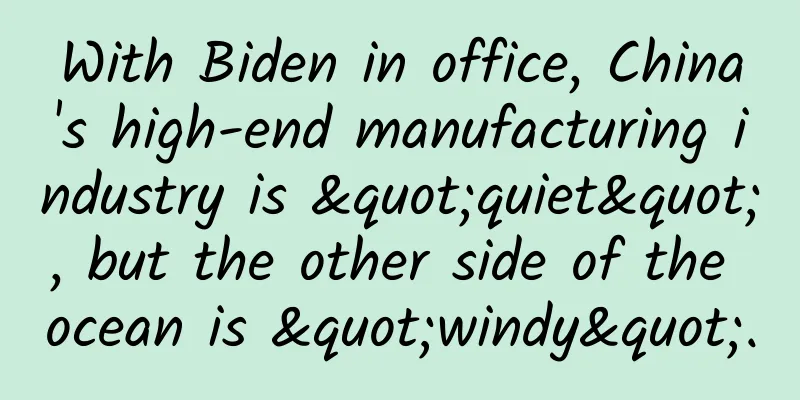With Biden in office, China's high-end manufacturing industry is "quiet", but the other side of the ocean is "windy".

|
As many international relations experts have previously asserted, the competition between China and the United States may continue for decades. In terms of Sino-US relations, especially the policy of suppressing China's high-end manufacturing industry, the newly elected US President Biden may not bring any changes, especially when the incoming Secretary of State Blinken expressed his "recognition of Trump's China policy", many people who had expected Biden to give up their illusions. Self-improvement and struggle will never stop, and realizing the independence of China's high-end manufacturing industry as soon as possible is still our star and sea. The “Hidden” American Manufacturing Industry The American industry is actually very strong. When many people see that the output value of the US service industry accounts for 80% of GDP, they think that the US has given up manufacturing. This is actually a big mistake. They are just blinded by the appearance of macroeconomic data. Nian Yong, former director of the Industry Department of the National Development and Reform Commission, once said at the "2020 China Internet Manufacturing Summit": "The United States has never given up on manufacturing. Last year, the U.S. service industry accounted for 81% of the total economy, but more than 60% of it served the manufacturing industry." Although the direct output value data of the US manufacturing industry is not impressive, it can still maintain its position as the world's number one power, mainly because it has accumulated unfathomable technological advantages in high-end manufacturing. Taking the well-known iPhone as an example, Apple can take away 66% of the profit margin by only being responsible for product design, market and marketing, while the Foxconn factory, which works overtime, "only makes $4 to $4.5 per phone", with a profit margin of only 2%. In other words, as long as the United States masters core manufacturing technologies, it can make people from all over the world work for it and seek rewards no matter where its manufacturing base is located. This unique industrial structure also influences and determines the United States' foreign policy, which seems loose but is actually aggressive. In the 1970s and 1980s, Japan, with its rapidly developing economy, built a complete semiconductor industry chain. Data shows that in 1985, Japan's semiconductor market share surpassed that of the United States for the first time, ranking first in the world. In 1988, Japan's semiconductor output value accounted for 67% of the world's total chip output value. Feeling threatened, the United States restricted the development of Japanese semiconductors through policies such as the Semiconductor Agreement, while at the same time reducing Japan's influence in the semiconductor industry by supporting South Korea in implementing the Very Large Scale Integrated Circuit Technology Joint Development Program. As we have seen in the end, in February 2012, under the joint suppression of the United States and South Korea, Elpida, the last spark of Japan's semiconductor industry, declared bankruptcy, and the Japanese semiconductor industry could no longer recover. Even his own younger brother could suffer such a fate, let alone facing China which has technology, market and ambition? America's strategy rarely wavers It is a well-known fact that Biden’s coming to power and Trump’s decline are also inextricably linked to the American manufacturing industry. From a holistic perspective, although the United States can dominate the world with its core technologies, it cannot be ignored that there are also "downstream citizens" in the United States who need to rely on manufacturing to work and make money. When these jobs are transferred, these people from the "Rust Belt" will lose their source of income. A US media investigation showed that in 2013, five years after the closure of General Motors' oldest Janesville plant, about 41,000 families in the area were making ends meet by receiving "food sharing coupons", which was twice the number when the plant closed. In 2016, Trump discovered this secret and, while shouting “Make America Great Again,” emphasized that he would bring manufacturing back to the United States. As a result, Trump instantly gained the support of millions of unemployed workers and their families. However, Rome was not built in a day. America's low-end manufacturing industry has not returned, and in fact there is no possibility of its return. Nevertheless, while occupying the upstream of high-end manufacturing, bringing low-end manufacturing back to the United States has long been a public opinion. As early as 2018, Biden published a signed article in Foreign Affairs, saying: "The United States does need to take a tough stance against China." He emphasized that the United States must rebuild its core supply chain and gradually restore its manufacturing industry to reduce its over-reliance on Chinese goods. From this, we can find that in core manufacturing fields such as semiconductors and medical care, Biden will still adhere to the American-based strategy, while in peripheral manufacturing, due to the poor epidemic prevention and control in the United States and China's inherent industrial chain advantages, Biden may choose a continuity strategy that will not be touched for the time being. In addition, unlike Trump's blatant behavior, as a Democratic politician, especially the vice president of the Obama administration, if nothing unexpected happens, Biden will once again stand on the so-called "moral" high ground, uphold American values, and win over a group of younger brothers to isolate China. Based on these two levels, we can find that in fact, in terms of the core attitude towards China, Biden and Trump, as US presidents, are actually exactly the same: insisting on suppressing China's high-end manufacturing industry. China's manufacturing industry must transform and upgrade Many people believe that with the experience of "China Factory" helping China's rise in the past 20 years, we only need to follow this route in the future and we will also have a good future. However, factors such as the environment, population, and raw material costs determine that "China Factory" is not a sustainable development strategy. Taking population as an example, the data from the Human Capital and Labor Economics Research Center of the Central University of Finance and Economics released the "China Human Capital Report 2019", which showed that from 1985 to 2017, the average annual growth rate of human capital per capita in China was 6.99%. In the short ten years from 2008 to 2017, the average annual growth rate of human capital per capita increased to 7.05%. After 2011, my country's labor force population showed a downward trend. The labor force has been decreasing again and again, while human capital is increasing, which means that it will be difficult for factories to obtain cheap labor in the future. In response to these problems, Wu Xiaobo once said: "The way out for China's manufacturing industry in the future is transformation and upgrading. The entire manufacturing model must get rid of its dependence on cost and scale." Therefore, even if we ignore the tough stance required for the debate with the United States and only consider our own national conditions, my country's manufacturing industry must master core industrial technologies and achieve an industrial breakthrough. Although correspondingly, with Biden coming to power, China will not be less vulnerable to attacks in the future, but for a self-reliant China like today, it is definitely impossible to follow Japan's old path. China has a vast domestic market, and for some time to come, China will remain the world's largest domestic demand market. The recent strategy of "building a new development pattern with domestic circulation as the main focus and domestic and foreign dual circulation" actually shows the government's strong confidence in the domestic market. Secondly, the long-term development of the manufacturing industry has accumulated profound advantages in the industrial chain cluster. After decades of development, many industries in my country have corresponding layouts in the upstream and downstream of the industrial chain. This natural manufacturing cost advantage is the main reason why the US's tough suppression policy has failed, and it is also the underlying foundation for China's manufacturing industry to move to a higher level. Third, the opportunity of the intelligent revolution. Throughout history, we can find that each industrial revolution will trigger the transfer of industrial positions, such as the first industrial revolution in Britain, the second industrial revolution in Europe, and the third industrial revolution in the United States. Wu Xiaobo believes: "When China's manufacturing industry was facing difficulties, the intelligent revolution (the fourth industrial revolution) took place. In this respect, we are luckier than the Japanese." From the perspective of the external environment, even if Biden can restrict the development of China's manufacturing industry through alliances, isolation, economic sanctions and other means, we can find that these three advantages of China's manufacturing industry are very similar to what the ancients often said about "the right time, the right place and the right people", and will not be greatly shaken by changes in the external environment. Therefore, as Peter Harris, a doctoral student in the Department of Political Science at the University of Texas at Austin, said: "Despite numerous obstacles, China is likely to replace the United States as the world's dominant military and geopolitical force in due course." As a winner of Toutiao's Qingyun Plan and Baijiahao's Bai+ Plan, the 2019 Baidu Digital Author of the Year, the Baijiahao's Most Popular Author in the Technology Field, the 2019 Sogou Technology and Culture Author, and the 2021 Baijiahao Quarterly Influential Creator, he has won many awards, including the 2013 Sohu Best Industry Media Person, the 2015 China New Media Entrepreneurship Competition Beijing Third Place, the 2015 Guangmang Experience Award, the 2015 China New Media Entrepreneurship Competition Finals Third Place, and the 2018 Baidu Dynamic Annual Powerful Celebrity. |
Recommend
Can the magic medicine that promises “immortality” and “longevity” really extend life?
If someone says: There really is an elixir of lif...
The "big claws" that reveal the secrets of evolution? Come and see the whole process of the "big crab" cutting RNA!
On January 25, 2025, Beijing time, Shen Enzhi'...
The world's first AIMS telescope breaks through the difficulty of measuring the solar magnetic field
Reporters learned from the Qinghai Lenghu Astrono...
Jack Ma is so awesome, why do we still need TV stations for Singles’ Day?
1. The show begins On the evening of November 10,...
Guide to the basic process of opening an account for Tencent advertising!
Basic account opening process Please note: 1. An ...
Carbon dioxide can be used to make plastics? You heard it right!
Author: Li Chuanfu Shi Xiangqi As the global clim...
What is word-of-mouth marketing? How can companies do word-of-mouth marketing well?
There are many ways of online marketing, such as:...
7 essential promotion skills for operators! Did you know?
01 Promotion skills For operations personnel, whe...
Market opportunities brought by the legalization of homosexuality in the United States: O2O and wearables
On June 26, nine judges of the U.S. Supreme Court...
Are there any rules behind the operations of successful products such as Weibo, Zhihu, and Didi?
Regarding the life and death of a product, how sh...
100,000 yuan entry-level compact domestic SUV, which one do you choose, Tiggo 8 Pro or Changan CS75 Plus?
The 2025 Chery Tiggo 8 PRO has five models, with ...
In-depth | Talk about the operational strategy of AARRR model in e-commerce marketing activities
The " AARRR Model " is a concept mentio...
Relay satellites: making manned space flight and deep space exploration more convenient
On July 13, 2022, my country's Long March 3B ...
New media operation—build operational thinking!
New media operations are commonly known as "...









